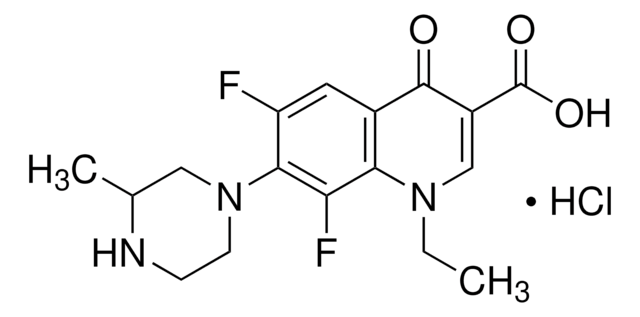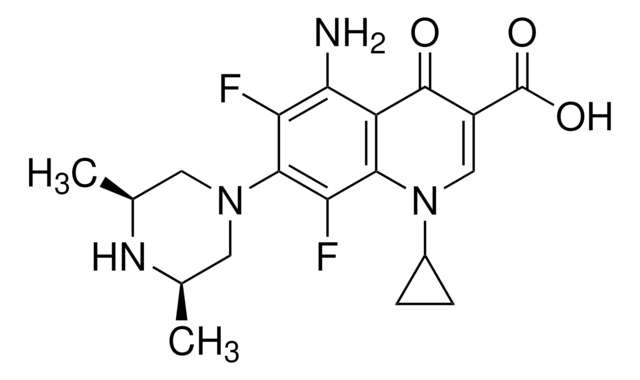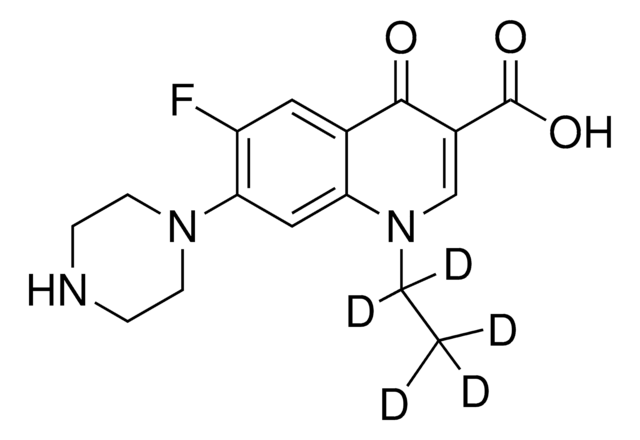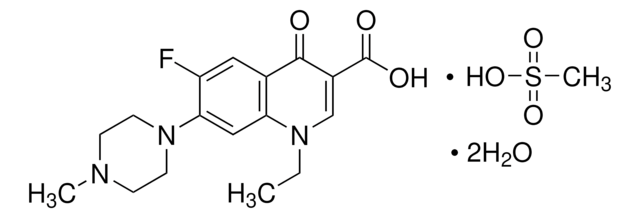おすすめの製品
グレード
analytical standard
品質水準
認証
EPA 1694
アッセイ
≥98% (TLC)
テクニック
HPLC: suitable
gas chromatography (GC): suitable
アプリケーション
clinical testing
フォーマット
neat
保管温度
2-8°C
SMILES記法
CCN1C=C(C(O)=O)C(=O)c2cc(F)c(cc12)N3CCNCC3
InChI
1S/C16H18FN3O3/c1-2-19-9-11(16(22)23)15(21)10-7-12(17)14(8-13(10)19)20-5-3-18-4-6-20/h7-9,18H,2-6H2,1H3,(H,22,23)
InChI Key
OGJPXUAPXNRGGI-UHFFFAOYSA-N
遺伝子情報
human ... CYP1A2(1544)
rat ... Gabra1(29705)
類似した製品をお探しですか? 訪問 製品比較ガイド
詳細
アプリケーション
生物化学的/生理学的作用
作用機序:細菌DNA複製を阻害します。
抗菌スペクトル:グラム陰性菌。グラム陽性菌に対しては低効果。
保管分類コード
11 - Combustible Solids
WGK
WGK 2
引火点(°F)
Not applicable
引火点(℃)
Not applicable
個人用保護具 (PPE)
Eyeshields, Gloves, type N95 (US)
適用法令
試験研究用途を考慮した関連法令を主に挙げております。化学物質以外については、一部の情報のみ提供しています。 製品を安全かつ合法的に使用することは、使用者の義務です。最新情報により修正される場合があります。WEBの反映には時間を要することがあるため、適宜SDSをご参照ください。
Jan Code
N9890-25G:
N9890-1G:
N9890-VAR:
N9890-5G:
N9890-BULK:
Choose from one of the most recent versions:
試験成績書(COA)
Don't see the Right Version?
If you require a particular version, you can look up a specific certificate by the Lot or Batch number.
この製品を見ている人はこちらもチェック
資料
Quinolones are a key group of antibiotics that interfere with DNA synthesis by inhibiting topoisomerase, most frequently topoisomerase II (DNA gyrase), an enzyme involved in DNA replication.
ライフサイエンス、有機合成、材料科学、クロマトグラフィー、分析など、あらゆる分野の研究に経験のあるメンバーがおります。.
製品に関するお問い合わせはこちら(テクニカルサービス)












